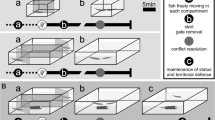Synopsis
The rim circling (RC), and aggressive habituation of nesting bluegills were studied in natural colonies during the six days of the reproductive period following spawning. To examine the stimulus specificity of aggressive habituation, selected test individuals and four neighbors were observed on four occasions during one day. After the first observation period established baseline data on aggressive interactions, the ‘appearances’ of three of the neighbors were manipulated and further observations were made. Two more observation periods followed, separated by a sham manipulation to allow for possible disturbance effects. Fish lengths, inter-nest distances, and positions in the colony were also recorded.
An analysis of the data demonstrated that aggressive interaction increased for the three manipulated neighbors. There were no significant differences among the data for the fourth (control) neighbors. The enhanced aggressive interactions between the test and manipulated males were initiated by the males at least partially in response to the changed appearance of the neighbor. Further, the level of aggressive interaction returned to normal after about 2 hours, indicating that the test male had habituated to the new appearances of his neighbors. Thus visual appearance plays an important role in the habituation of aggression between neighboring bluegills. It was not possible to determine if the behavior of the neighbor was also an important cue used in aggressive habituation, but this seems likely. Advantages of aggressive habituation are discussed. It is noteworthy that aggression decreased as internest distance increased.
Levels of RC varied significantly over the six days, in a time course dissimilar from aggression. The RC rate is dependent on size of male, nest locality, and circling activity of neighbors. Observations on the synchrony of rim circling indicated social facilitation. It is argued that RC probably fulfills an advertisement function important in defending the brood. The motivation for RC is likely complex, and its performance reflects a mixed aggressive and reproductive strategy in the nesting population. Aggressive habituation functions in the social organization of bluegills to facilitate the occurrence of group displays such as RC.
Similar content being viewed by others
References cited
Assem, van den, J. & J. N. van der Molen. 1969. Waning of the aggressive response in the three-spined stickleback upon constant exposure to a conspecific. I. A preliminary analysis of the phenomenon. Behaviour 34: 288–324.
Avila, V. L. 1976. A field study of nesting behavior of male bluegill sunfish (Lepomis macrochirus Rafinesque). Am. Midl. Nat. 96: 195–206.
Baerends, G. P. & J. M. Baerends van Roon. 1950. An introduction to the study of the ethology of cichlid fishes. Behaviour Suppl. 1: 1–242.
Ballantyne, P. K. & P. W. Colgan. 1978. Sound production during agonistic and reproductive behavior in the pumpkinseed (Lepomis gibbosus), the bluegill (L. macrochirus), and their hybrid sunfish. I: Context. II: Recipients. III: Response. Biology of Behaviour 3: 113–135.
Brooks, R. J. & J. B. Falls. 1975. Individual recognition by song in whitethroated sparrows. I: Discrimination of songs of neighbors and strangers. III. Song features used in individual recognition. Can. J. Zool. 53: 879–888, 1749–1761.
Butler, M. & D. A. Johnson. 1972. A test of individual recognition in bluegill sunfish using operant procedures. Virginia J. Sci. 23: 149.
Colgan, P. W. & M. R. Gross. 1977. Dynamics of aggression in pumpkinseed sunfish (Lepomis gibbosus) over the nesting phase. Zeit. f. Tierpsychol. 43: 139–151.
Falls, J. B. & R. J. Brooks. 1975. Individual recognition by song in whitethroated sparrows. II: Effects of location. Can. J. Zool. 53: 1412–1420.
Fricke, H. W. 1973. Individual partner recognition in fish field studies on Amphiprion bicinctus. Naturw. 60: 204–205.
Gandolfi, G., R. Gandolfi, & F. Le Moli. 1973. Short-term individual recognition in Padogobius martensi (Teleostei, Gobiidae). Atti. Acad. Naz. Lincei Mem. Cl. Fis. Mat. Nat. Ser. 8, 54: 281–285.
Gerald, J. W. 1970. Species isolating mechanisms in the genus Lepomis. Ph. D. thesis, Univ. Texas. 00 pp.
Henderson, D. L. & D. A. Chiszar. 1977. Analysis of aggressive behaviour in the bluegill sunfish Lepomis macrochirus Rafinesque: Effects of sex and size. Anim. Behav. 15: 122–130.
Huntingford, F. A. 1977. Inter- and intraspecific aggression in male sticklebacks. Copeia 1977: 158–159.
Miller, H. C. 1963. The behavior of the pumpkinseed sunfish, Lepomis gibbosus (Linnaeus), with notes on the behavior: of other species of Lepomis and the pigmy sunfish, Elassoma evergladei. Behaviour 22: 88–151.
Noble, G. K. & B. Curtis. 1939. The social behavior of the jewel fish, Hemichromis bimaculatus Gill. Bull. Am. Mus. Nat. Hist. 76: 1–46.
Peeke, H. V. S. & S. C. Peeke. 1973. Habituation in fish with special reference to intraspecific aggressive behavior. pp. 59–83. In H. V. S. Peeke & M. J. Herz (ed.) Habituation. V.I. Behavioral studies. New York: Academic Press.
Peeke, H. V. S. & A. Veno. 1973. Stimulus specificity of habituated aggression in stickleback (Gasterosteus aculeatus). Behav. Biol. 8: 427–432.
Nelson, K. 1964. Behavior and morphology in the glandulocaudine fishes (Ostariophysi, Characidae). Univ. Calif. Publ. Zool. 75: 59–152.
Siegel, S. 1956. Nonparametric statistics for the behavioral sciences. New York: McGraw-Hill. 312 pp.
Stacey, P. B. & D. Chiszar. 1978. Body color pattern and the aggressive behavior of male pumpkinseed sunfish (Lepomis gibbosus) during the reproductive season. Behaviour 64: 271–297.
Thorpe, W. H. 1963. Learning and instict in animals. 2nd ed. Harvard University Press, Cambridge. 558 pp.
Wilson, E. O. 1975. Sociobiology. Harvard University Press, Cambridge. 697 pp.
Zayan, R. C. 1975. Defense du territoire et reconnaissance individuelle chez Xiphophorus (Pisces, Poeciliidae). Behaviour 52: 266–312.
Author information
Authors and Affiliations
Rights and permissions
About this article
Cite this article
Colgan, P.W., Nowell, W.A., Gross, M.R. et al. Aggressive habituation and rim circling in the social organization of bluegill sunfish (Lepomis macrochirus). Environ Biol Fish 4, 29–36 (1979). https://doi.org/10.1007/BF00005925
Received:
Accepted:
Issue Date:
DOI: https://doi.org/10.1007/BF00005925




